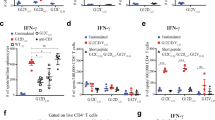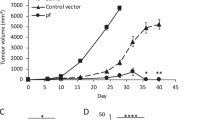Abstract
Cationic liposomes have been shown to potentiate markedly the ability of plasmid DNA to activate innate immune responses. We reasoned therefore that liposome–DNA complexes (LDC) could be used to produce more effective plasmid DNA vaccines for cancer. To test this hypothesis, tumor-bearing mice were vaccinated with conventional plasmid DNA vaccines or with LDC vaccines encoding model tumor antigens and CD8+ T-cell responses and antitumor activity were assessed. We found that although plasmid DNA vaccines generated large increases in antigen-specific CD8+ T cells, they failed to elicit significant antitumor immunity. In contrast, LDC vaccines elicited large numbers of antigen-specific CD8+ T cells and also generated significant antitumor activity against established tumors. The antitumor activity elicited by immunization with LDC vaccines was mediated primarily by CD8+ T cells. Studies of the interaction of LDC with antigen-presenting cells found that LDC triggered dendritic cell production of interleukin-12 and interferon (IFN)-γ production by natural killer cells in vivo. Activation by LDC was also accompanied by upregulation of costimulatory molecule expression. These findings suggest that by concurrently activating strong systemic innate immune responses and generating cytotoxic T-lymphocyte responses, LDC may be used to increase the effectiveness of therapeutic plasmid DNA vaccination for cancer.
This is a preview of subscription content, access via your institution
Access options
Subscribe to this journal
Receive 12 print issues and online access
$259.00 per year
only $21.58 per issue
Buy this article
- Purchase on Springer Link
- Instant access to full article PDF
Prices may be subject to local taxes which are calculated during checkout







Similar content being viewed by others
References
Boyd D, Hung CF, Wu TC . DNA vaccines for cancer. IDrugs 2003; 6: 1155–1164.
Lysaght J, Todryk S . Developments in cancer vaccination. Curr Opin Invest Drugs 2003; 4: 716–721.
Moingeon P . Cancer vaccines. Vaccine 2001; 19: 1305–1326.
Pardoll DM . Cancer vaccines. Nat Med 1998; 4: 525–531.
Prud’homme GJ . DNA vaccination against tumors. J Gene Med 2005; 7: 3–17.
Dudley ME, Wunderlich JR, Robbins PF, Yang JC, Hwu P, Schwartzentruber DJ et al. Cancer regression and autoimmunity in patients after clonal repopulation with antitumor lymphocytes. Science 2002; 298: 850–854.
Overwijk WW, Theoret MR, Finkelstein SE, Surman DR, de Jong LA, Vyth-Dreese FA et al. Tumor regression and autoimmunity after reversal of a functionally tolerant state of self-reactive CD8+T cells. J Exp Med 2003; 198: 569–580.
Rosenberg SA, Yang JC, Restifo NP . Cancer immunotherapy: moving beyond current vaccines. Nat Med 2004; 10: 909–915.
Bodey B, Bodey Jr B, Siegel SE, Kaiser HE . Failure of cancer vaccines: the significant limitations of this approach to immunotherapy. Anticancer Res 2000; 20: 2665–2676.
Chen CH, Ji H, Suh KW, Choti MA, Pardoll DM, Wu TC . Gene gun-mediated DNA vaccination induces antitumor immunity against human papillomavirus type 16 E7-expressing murine tumor metastases in the liver and lungs. Gene Therapy 1999; 6: 1972–1981.
Dranoff G . GM-CSF-based cancer vaccines. Immunol Rev 2002; 188: 147–154.
Figdor CG, de Vries IJ, Lesterhuis WJ, Melief CJ . Dendritic cell immunotherapy: mapping the way. Nat Med 2004; 10: 475–480.
Dranoff G, Jaffee E, Lazenby A, Golumbek P, Levitsky H, Brose K et al. Vaccination with irradiated tumor cells engineered to secrete murine granulocyte–macrophage colony-stimulating factor stimulates potent, specific, and long-lasting anti-tumor immunity. Proc Natl Acad Sci USA 1993; 90: 3539–3543.
Leitner WW, Hwang LN, deVeer MJ, Zhou A, Silverman RH, Williams BR et al. Alphavirus-based DNA vaccine breaks immunological tolerance by activating innate antiviral pathways. Nat Med 2003; 9: 33–39.
Lesterhuis WJ, de Vries IJ, Adema GJ, Punt CJ . Dendritic cell-based vaccines in cancer immunotherapy: an update on clinical and immunological results. Ann Oncol 2004; 15 (Suppl 4): iv145–iv151.
Mach N, Dranoff G . Cytokine-secreting tumor cell vaccines. Curr Opin Immunol 2000; 12: 571–575.
Melief CJ, Offringa R, Toes RE, Kast WM . Peptide-based cancer vaccines. Curr Opin Immunol 1996; 8: 651–657.
Offringa R, van der Burg SH, Ossendorp F, Toes RE, Melief CJ . Design and evaluation of antigen-specific vaccination strategies against cancer. Curr Opin Immunol 2000; 12: 576–582.
Pardoll DM . Therapeutic vaccination for cancer. Clin Immunol 2000; 95: S44–S62.
Restifo NP, Ying H, Hwang L, Leitner WW . The promise of nucleic acid vaccines. Gene Therapy 2000; 7: 89–92.
Pavlenko M, Leder C, Pisa P . Plasmid DNA vaccines against cancer: cytotoxic T-lymphocyte induction against tumor antigens. Expert Rev Vaccines 2005; 4: 315–327.
Park JH, Kim CJ, Lee JH, Shin SH, Chung GH, Jang YS . Effective immunotherapy of cancer by DNA vaccination. Mol Cells 1999; 9: 384–391.
Stevenson FK, Ottensmeier CH, Johnson P, Zhu D, Buchan SL, McCann KJ et al. DNA vaccines to attack cancer. Proc Natl Acad Sci USA 2004; 101 (Suppl 2): 14646–14652.
Triozzi PL, Aldrich W, Allen KO, Carlisle RR, LoBuglio AF, Conry RM . Phase I study of a plasmid DNA vaccine encoding MART-1 in patients with resected melanoma at risk for relapse. J Immunother 2005; 28: 382–388.
Tuting T, Gambotto A, DeLeo A, Lotze MT, Robbins PD, Storkus WJ . Induction of tumor antigen-specific immunity using plasmid DNA immunization in mice. Cancer Gene Ther 1999; 6: 73–80.
Schreurs MW, de Boer AJ, Figdor CG, Adema GJ . Genetic vaccination against the melanocyte lineage-specific antigen gp100 induces cytotoxic T lymphocyte-mediated tumor protection. Cancer Res 1998; 58: 2509–2514.
Weber LW, Bowne WB, Wolchok JD, Srinivasan R, Qin J, Moroi Y et al. Tumor immunity and autoimmunity induced by immunization with homologous DNA. J Clin Invest 1998; 102: 1258–1264.
Tuting T, Gambotto A, Robbins PD, Storkus WJ, DeLeo AB . Co-delivery of T helper 1-biasing cytokine genes enhances the efficacy of gene gun immunization of mice: studies with the model tumor antigen beta-galactosidase and the BALB/c Meth A p53 tumor-specific antigen. Gene Therapy 1999; 6: 629–636.
Irvine KR, Rao JB, Rosenberg SA, Restifo NP . Cytokine enhancement of DNA immunization leads to effective treatment of established pulmonary metastases. J Immunol 1996; 156: 238–245.
Ross HM, Weber LW, Wang S, Piskun G, Dyall R, Song P et al. Priming for T-cell-mediated rejection of established tumors by cutaneous DNA immunization. Clin Cancer Res 1997; 3: 2191–2196.
Shimizu K, Fields RC, Giedlin M, Mule JJ . Systemic administration of interleukin 2 enhances the therapeutic efficacy of dendritic cell-based tumor vaccines. Proc Natl Acad Sci USA 1999; 96: 2268–2273.
Brinckerhoff LH, Thompson LW, Slingluff Jr CL . Melanoma vaccines. Curr Opin Oncol 2000; 12: 163–173.
Pardoll DM, Beckerleg AM . Exposing the immunology of naked DNA vaccines. Immunity 1995; 3: 165–169.
Dow SW, Fradkin LG, Liggitt DH, Willson AP, Heath TD, Potter TA . Lipid–DNA complexes induce potent activation of innate immune responses and antitumor activity when administered intravenously. J Immunol 1999; 163: 1552–1561.
Sellins K, Fradkin L, Liggitt D, Dow S . Type I interferons potently suppress gene expression following gene delivery using liposome(−)DNA complexes. Mol Ther 2005; 12: 451–459.
Whitmore M, Li S, Huang L . LPD lipopolyplex initiates a potent cytokine response and inhibits tumor growth. Gene Therapy 1999; 6: 1867–1875.
Dow SW, Elmslie RE, Fradkin LG, Liggitt DH, Heath TD, Willson AP et al. Intravenous cytokine gene delivery by lipid–DNA complexes controls the growth of established lung metastases. Hum Gene Ther 1999; 10: 2961–2972.
Whitmore MM, Li S, Falo Jr L, Huang L . Systemic administration of LPD prepared with CpG oligonucleotides inhibits the growth of established pulmonary metastases by stimulating innate and acquired antitumor immune responses. Cancer Immunol Immunother 2001; 50: 503–514.
Zhu N, Liggitt D, Liu Y, Debs R . Systemic gene expression after intravenous DNA delivery into adult mice. Science 1993; 261: 209–211.
Liu Y, Liggitt D, Zhong W, Tu G, Gaensler K, Debs R . Cationic liposome-mediated intravenous gene delivery. J Biol Chem 1995; 270: 24864–24870.
Templeton NS, Lasic DD, Frederik PM, Strey HH, Roberts DD, Pavlakis GN . Improved DNA:liposome complexes for increased systemic delivery and gene expression. Nat Biotechnol 1997; 15: 647–652.
Wexler H . Accurate identification of experimental pulmonary metastases. J Natl Cancer Inst 1966; 36: 641–645.
Kurts C, Heath WR, Carbone FR, Allison J, Miller JF, Kosaka H . Constitutive class I-restricted exogenous presentation of self antigens in vivo. J Exp Med 1996; 184: 923–930.
Ahonen CL, Doxsee CL, McGurran SM, Riter TR, Wade WF, Barth RJ et al. Combined TLR and CD40 triggering induces potent CD8+T cell expansion with variable dependence on type I IFN. J Exp Med 2004; 199: 775–784.
Dow S, Elmslie R, Kurzman I, Macewen G, Pericle F, Liggitt D . Phase I study of liposome–DNA complexes encoding the interleukin-2 gene in dogs with osteosarcoma lung metastases. Hum Gene Ther 2005; 16: 937–946.
Bosio CM, Goodyear AW, Dow SW . Early interaction of Yersinia pestis with APCs in the lung. J Immunol 2005; 175: 6750–6756.
Roman M, Martin-Orozco E, Goodman JS, Nguyen MD, Sato Y, Ronaghy A et al. Immunostimulatory DNA sequences function as T helper-1-promoting adjuvants. Nat Med 1997; 3: 849–854.
Chattergoon MA, Robinson TM, Boyer JD, Weiner DB . Specific immune induction following DNA-based immunization through in vivo transfection and activation of macrophages/antigen-presenting cells. J Immunol 1998; 160: 5707–5718.
O’Hagan DT . Recent developments in vaccine delivery systems. Curr Drug Targets Infect Disord 2001; 1: 273–286.
Gregoriadis G, Bacon A, Caparros-Wanderley W, McCormack B . A role for liposomes in genetic vaccination. Vaccine 2002; 20 (Suppl 5): B1–B9.
Gursel M, Tunca S, Ozkan M, Ozcengiz G, Alaeddinoglu G . Immunoadjuvant action of plasmid DNA in liposomes. Vaccine 1999; 17: 1376–1383.
Bu J, Song Y, Rompato G, Burgess DJ, Garmendia AE . Co-delivery of IL-2 or liposomes augment the responses of mice to a DNA vaccine for pseudorabies virus IE180. Comp Immunol Microbiol Infect Dis 2003; 26: 175–187.
Perrie Y, Frederik PM, Gregoriadis G . Liposome-mediated DNA vaccination: the effect of vesicle composition. Vaccine 2001; 19: 3301–3310.
Friend DS, Papahadjopoulos D, Debs RJ . Endocytosis and intracellular processing accompanying transfection mediated by cationic liposomes. Biochim Biophys Acta 1996; 1278: 41–50.
Zuhorn IS, Hoekstra D . On the mechanism of cationic amphiphile-mediated transfection. To fuse or not to fuse: is that the question? J Membr Biol 2002; 189: 167–179.
Yasuda K, Ogawa Y, Yamane I, Nishikawa M, Takakura Y . Macrophage activation by a DNA/cationic liposome complex requires endosomal acidification and TLR9-dependent and -independent pathways. J Leukocyte Biol 2005; 77: 71–79.
Kamstock D, Guth A, Elmslie R, Kurzman I, Liggitt D, Coro L et al. Liposome–DNA complexes infused intravenously inhibit tumor angiogenesis and elicit antitumor activity in dogs with soft tissue sarcoma. Cancer Gene Ther 2006; 13: 306–317.
Acknowledgements
We would like to acknowledge Mr Andrew Willson for technical assistance with these studies. This work was supported by a Grant CA 86224 from the NIH (SD), by a fellowship from the Cancer Research Institute (RK) and by a training Grant T32RR00707 from the NIH (LU), and by the Valentis Corporation.
Author information
Authors and Affiliations
Corresponding author
Rights and permissions
About this article
Cite this article
U'Ren, L., Kedl, R. & Dow, S. Vaccination with liposome–DNA complexes elicits enhanced antitumor immunity. Cancer Gene Ther 13, 1033–1044 (2006). https://doi.org/10.1038/sj.cgt.7700982
Received:
Revised:
Accepted:
Published:
Issue Date:
DOI: https://doi.org/10.1038/sj.cgt.7700982
Keywords
This article is cited by
-
Evaluation of antigen specific recognition and cell mediated cytotoxicity by a modified lysispot assay in a rat colon carcinoma model
Journal of Experimental & Clinical Cancer Research (2012)
-
Mechanisms of action underlying the immunotherapeutic activity of Allovectin in advanced melanoma
Cancer Gene Therapy (2012)
-
Anti-tumor effects of a human VEGFR-2-based DNA vaccine in mouse models
Genetic Vaccines and Therapy (2009)



